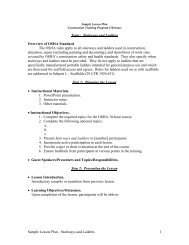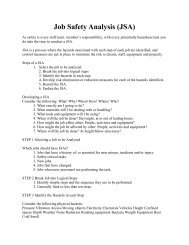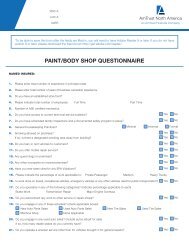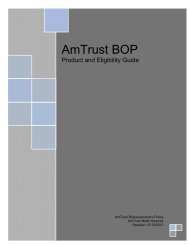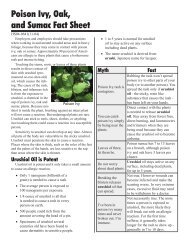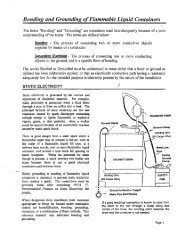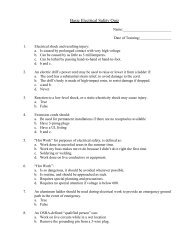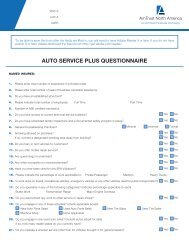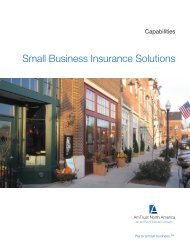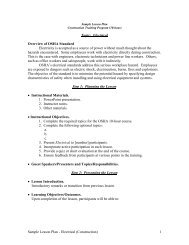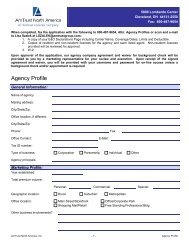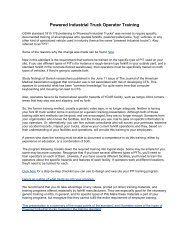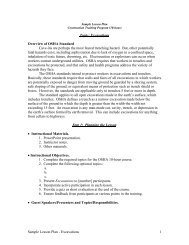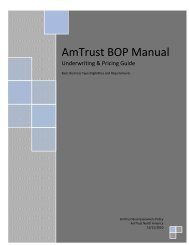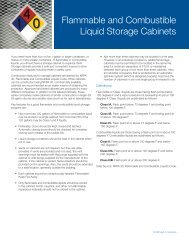Sample Lesson Plan - Cranes 1 Topic: Cranes Overview of OSHA ...
Sample Lesson Plan - Cranes 1 Topic: Cranes Overview of OSHA ...
Sample Lesson Plan - Cranes 1 Topic: Cranes Overview of OSHA ...
You also want an ePaper? Increase the reach of your titles
YUMPU automatically turns print PDFs into web optimized ePapers that Google loves.
<strong>Sample</strong> <strong>Lesson</strong> <strong>Plan</strong><br />
Construction Training Program (10-hour)<br />
<strong>Topic</strong>: <strong>Cranes</strong><br />
<strong>Overview</strong> <strong>of</strong> <strong>OSHA</strong> Standard<br />
<strong>Cranes</strong> pose significant safety issues to be considered, both for the operators <strong>of</strong><br />
the diverse “lifting” devices, and for workers in proximity to them. Moving large, heavy<br />
loads is crucial to today’s manufacturing and construction industries, and much<br />
technology has been developed for these operations. Unfortunately, <strong>OSHA</strong>’s standards<br />
do not address many <strong>of</strong> the advancements in hoisting technology or equipment used in<br />
construction today since they have not been updated since 1971 and rely heavily on<br />
outdated 1968 American National Standards Institute (ANSI) consensus standards.<br />
The American National Standards Institute (ANSI) and the American Society <strong>of</strong><br />
Mechanical Engineers (ASME), through consensus procedures, continually update<br />
standards for crane manufacturing, operational procedures, inspection requirements, and<br />
operator qualifications. Many construction employers adopt these standards. In addition,<br />
the Specialized Carriers and Riggers Associate (SC&RA0, which represents most <strong>of</strong> the<br />
construction crane owners and users, have developed a set <strong>of</strong> requirements for crane<br />
operator qualifications and certification.<br />
• Instructional Materials.<br />
1. PowerPoint presentation.<br />
2. Instructor notes.<br />
3. Other materials.<br />
Step 1: <strong>Plan</strong>ning the <strong>Lesson</strong><br />
• Instructional Objectives.<br />
1. Complete the required topics for the <strong>OSHA</strong> 10-hour course.<br />
2. Complete the following optional topics:<br />
a.<br />
b.<br />
c.<br />
3. Present <strong>Cranes</strong> to [number] participants.<br />
4. Incorporate active participation in each lesson.<br />
5. Provide a quiz or short evaluation at the end <strong>of</strong> the course.<br />
6. Ensure feedback from participants at various points in the training.<br />
• Guest Speakers/Presenters and <strong>Topic</strong>s/Responsibilities.<br />
Step 2: Presenting the <strong>Lesson</strong><br />
• <strong>Lesson</strong> Introduction.<br />
Introductory remarks or transition from previous lesson.<br />
<strong>Sample</strong> <strong>Lesson</strong> <strong>Plan</strong> - <strong>Cranes</strong> 1
• Learning Objectives/Outcomes.<br />
Upon completion <strong>of</strong> the lesson, participants will be able to:<br />
1. List the four major causes <strong>of</strong> crane accidents.<br />
Possible responses.<br />
• Contact with power lines<br />
• Overturns<br />
• Falls<br />
• Mechanical failures<br />
2. Describe the pre-planning that is required before putting a crane in use.<br />
Possible responses.<br />
• Ensure the crane is on a firm, supported surface, and is level within 1%<br />
• Determine the location <strong>of</strong> overhead power lines<br />
• Know the job site conditions (e.g. unstable soil or high winds)<br />
• Make other personnel on the job site aware <strong>of</strong> hoisting activities<br />
• Barricade access within the swing radius<br />
• Ensure a competent person inspects all machinery and equipment prior to<br />
each use<br />
• Consider the load limiting factors<br />
• Consider lifting principles<br />
3. State the two main precautions that apply to working with cranes near power<br />
lines.<br />
Possible responses.<br />
• Stay clear <strong>of</strong> all power lines. Clearance distance should be at least 10 feet,<br />
and at least 16 feet for 750 kV or higher.<br />
• Have an observer or “spotter” who has a clear view <strong>of</strong> the power lines and<br />
the working crane at all times. The crane operator and observer must be able<br />
to see each other and communicate.<br />
• <strong>Plan</strong>ned Activities, Discussion, or Participant Interaction<br />
Step 3: Evaluating Student Learning and Instruction<br />
• <strong>Lesson</strong> Evaluation and Comments.<br />
.<br />
<strong>Sample</strong> <strong>Lesson</strong> <strong>Plan</strong> - <strong>Cranes</strong> 2
References<br />
<strong>OSHA</strong> Standard: 29 CFR 1926 Subpart N (1926.550 to 1926.556)<br />
‣ www.osha-slc.gov/OshStd_toc/<strong>OSHA</strong>_Std_toc_1926_SUBPART_N.html<br />
<strong>OSHA</strong> Publications<br />
‣ http://www.osha-slc.gov/OshDoc/Additional.html<br />
• 3100 Crane or Derrick Suspended Personal Platforms<br />
<strong>OSHA</strong> References/Resources<br />
• Electronic Library <strong>of</strong> Construction Occupational Safety and Health<br />
Safety Hazards - <strong>Cranes</strong> and Hoists<br />
‣ http://www.cdc.gov/niosh/elcosh/docs/hazard/safety.html<br />
• <strong>OSHA</strong> Technical Links - Crane, Derrick and Hoist Safety<br />
‣ http://www.osha-slc.gov/SLTC/cranehoistsafety/index.html<br />
• <strong>OSHA</strong> Technical Links - Construction - Crane, Derrick and Hoist Safety<br />
‣ http://www.osha-slc.gov/SLTC/constructioncrane/index.html<br />
• Video - Crane Safety for the Site Superintendent<br />
‣ http://www.osha-slc.gov/SLTC/multimedia.html<br />
‣ http://www.osha-slc.gov/SLTC/video/cranesafety/video.html<br />
<strong>Sample</strong> <strong>Lesson</strong> <strong>Plan</strong> - <strong>Cranes</strong> 3



